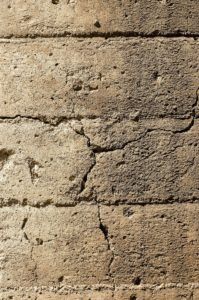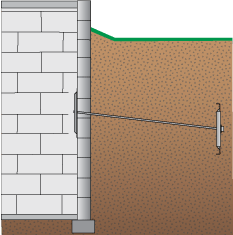Summer Rain Brings Bowing Walls
Summer is supposed to be a season of calm and relaxation. Sitting out in the yard, sunning yourself, going on vacation, and taking a break from the stressors of life. However, mother nature has a differing opinion on the summer season. Summer can be a huge season for storming and flooding, and this can take a toll on your home in the form of bowing walls. What starts off as a small crack in the wall will grow, worsen, and eventually turn into bowing walls.
What are Bowing Walls?

Another way to check if you have bowing walls is on the floor above. Are your doors or windows sticking? Do you have trouble opening them? Are their cracks on the upstairs walls? Is your chimney leaning? These can all be signs of foundation trouble below, including bowing walls. Bowing walls cause this trouble by not properly supporting the floor above and causing cracks and sticking doors and windows above.
What Causes Bowing Walls?
There are several different causes of bowing walls, but they usually lead back to one big problem: the home’s construction. When a home is built, the ground needs to be properly compacted and the soil around it needs to be compacted as well. When the foundation is dug out, there is extra room left around it for the workers to construction the home. However, this leaves the problem that the soil then needs to be backfilled and is looser than the rest of the soil. Water can easily get into this soil and cause it to become denser and push against the foundation, which is called hydrostatic pressure. This can cause cracks in the foundation wall because of unnecessary pressure.
After these cracks form, it will be easier for water from the soil to find its way into your home. Water problems will cause even more issues with the foundation by weakening it and allowing not only water inside but critters and pests. After awhile, the crack or cracks will get larger and larger and start to affect the structural integrity of the foundation wall. It will then begin to bow. It may be only a few inches, but those few inches can be a danger to the stability and structural integrity of your home. This is why crack repair for foundations is usually never the answer. A dual approach of foundation repair and crack repair (if needed) is the best way to go about fixing these issues.
How do you fix bowing walls?

Helical piers are a great option because they can be installed in any weather conditions with very little equipment. These piers will stabilize your foundation or porch and cause very little damage to the landscaping around your home.The effect of the installation is immediate, repairing your foundation and preventing future problems. They work by screwing deep into the ground and attaching to a plate on the foundation. The load of the foundation is then transferred to the pier.
Wall anchors are another solution to help with your bowing wall repair. A wall anchor is a plate that is fastened to your basement wall with a rod through the wall and into the soil beside your foundation. This rod is connected to another plate that is inserted into the ground about 10 feet away from the basement wall. Monthly tightening of the anchor can slowly pull your bowing wall back into its original position. It is done slowly so that your foundation is not put under undue stress and you can get the results that you want of a perfectly straight wall.
Helical wall tiebacks and anchors are another type of anchor that is installed very much like wall anchors, going through your wall and into the soil to give your bowing or leaning wall extra structural support. The pressure on the bowing wall is relieved through this process, and the anchor is used to straighten out the bowing wall.
Having Trouble with Bowing Walls? Call us Today!
If you’re having trouble with bowing walls after summer rains, it’s time to stop putting off foundation repair and get on the phone. Rapid Foundation Repair can get you started on fixing the issue and getting your home back to being safe and comfortable for you and your family. Please give us a call today, and we will be happy to assist you.
